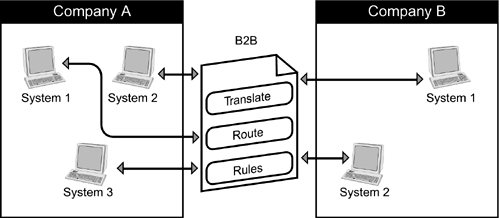The Process
| Although the Big Four consulting firms promote a number of methodologies for creating an automated supply chain, the process is really just like traditional system development with a twist. The first step is to automate and optimize all of the major business processes within each member organization. Attempting to integrate a supply chain before the members have their core systems in place will be costly, frustrating, and futile. The second step is to extend the enterprise to incorporate all members in the supply chain. This is the most difficult and time-consuming part of the process. This step requires psychology as well as technology. Once your members' hearts and souls are in the right place, you will find that application integration technology and techniques add the most value. At the heart of this process is a system architecture-and-design effort that extends the enterprise systems to all the member organizations. Not only is the enterprise being automated (and the process flows, object models, database models, and so on being created), but the way in which all of this integrates with other systems in other organizations is being defined. (In a way, this integration method is analogous to the integration process outlined for the types of application integration.) The end result is a common information infrastructure that integrates all member business systems with those of customers and suppliers. Once such an infrastructure is in place, the new family of application integration technology message brokers and application servers creates the best new opportunity to take command of the supply chain problem. Using message brokers, supply chain integrators can bind systems, even custom proprietary systems belonging to a trading partner, with their own enterprise systems. This is not significantly different from addressing any other integration problem in the enterprise. In this case, the problem domain is simply extended to include the relevant systems owned by the trading partners (see Figure 17.4). Here, you must rely on what we've learned in this book first defining the infrastructure for integration, then defining the processes that control communication between the systems. Figure 17.4. Supply chain integration builds on application integration techniques and technologies.
Throughout the process, organizations should look for opportunities to add value to the supply chain system, such as real-time decision support to increase responsiveness for example, defining triggers to automatically perform business processes, such as reordering inventory, increasing the marketing budget for a best-selling product, or informing management of other issues that need to be addressed. Other examples include evaluating an organization's leveraging systems to automatically select suppliers based on price and availability, freeing the staff from performing a complete analysis of the business drivers. This type of sophisticated processing lends itself well to the process integration or collaboration aspect of application integration; that is, the ability to create a workflow/process integration layer on top of existing interenterprise processes. A real-time solution brings with it the greatest degree of flexibility, because changing a process or a flow is a simple matter of dragging icons around on a screen. Near-time decision support information is important, as well. Almost all supply chain systems need to leverage the power of data warehousing technology to provide decision makers with the information they need to drop a product line, increase promotional activities, or normalize the number of participants in the supply chain. As I've suggested, in addition to the technical issues these solutions raise, there is a human component to the process. Supply chain integration is not complete unless it is accompanied by an investment in re-educating and reorienting employees, suppliers, and other interested parties. Too often "techies" forget about the "soft" aspects of supply chain integration only to discover that these soft aspects are as vital to the process as the hard aspects. Absent from this process is the ability for all players in the chain to make enterprise-wide commitments to creating and managing a complex organization and business system that better fits the needs of the market. Organizations that are doing this today will own the market in the future. |
EAN: 2147483647
Pages: 220
